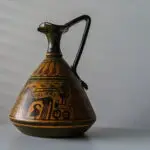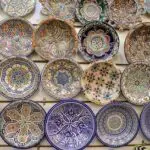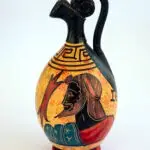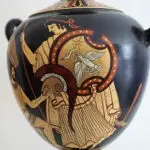Mediterranean pottery is a form of art that has been around for thousands of years. It has been influenced by the ancient Greeks, who were known for their exquisite pottery and vase designs. The pottery of ancient Greece was characterized by intricate decoration, including human figures, animals, and geometric patterns. The Greeks also developed a technique known as black-figure pottery and red-figure pottery, which involved painting figures and designs on the pottery in black or red.

Mediterranean pottery has not only been influenced by ancient Greek pottery but has also influenced other art forms. The intricate designs and patterns of Mediterranean pottery, including Greek vases, have been used in the decoration of buildings, furniture, vessels, and other objects. Pottery has also influenced the development of ceramics and other forms of pottery around the world. The ancient Athenian and Corinthian Greeks used pottery and vessels for a variety of purposes, including storing food and drink, as well as for religious and ceremonial purposes. The pottery was also used for trade, and Greek pottery has been found in archaeological sites all over the ancient world.
Key Takeaways
- Mediterranean pottery has been influenced by ancient Greek pottery, which was characterized by intricate decoration and black-figure and red-figure techniques.
- Mediterranean pottery has also influenced other art forms, including ceramics and the decoration of buildings and furniture.
- Ancient Greeks used pottery for a variety of purposes, including trade, religious, and ceremonial purposes.
Ancient Influences on Mediterranean Pottery
Mediterranean pottery has been influenced by a variety of cultures throughout history. This section explores some of the most significant ancient influences on Mediterranean pottery, including Mesopotamian, Greek (particularly Athens and Corinth) and Roman, and Islamic influences.
Mesopotamian Influence
One of the earliest and most significant influences on Mediterranean pottery was the Mesopotamian civilization. Mesopotamian pottery was characterized by intricate designs and the use of glazes. These techniques were adopted by the early Mediterranean civilizations, including the Minoans and Mycenaeans.
The Minoans, who lived on the island of Crete from around 3500 to 1100 BCE, were known for their exquisite pottery. They used a variety of techniques, including slip painting and lustrous glazing, to create intricate designs on their pottery. The Mycenaeans, who lived in mainland Greece from around 1750 to 1050 BCE, were also influenced by Mesopotamian pottery. They used similar techniques to create elaborate designs on their pottery, including scenes of warriors and chariots.
Greek and Roman Influence
The ancient Greeks and Romans also had a significant impact on Mediterranean pottery ware. Greek pottery was characterized by its red and black figure designs, which were created using a variety of techniques, including slip painting and incising. Roman pottery, on the other hand, was known for its use of molds and the production of large quantities of standardized pottery.
The influence of Greek and Roman pottery can be seen in the pottery of the Byzantine Empire, which lasted from the 4th to the 15th century CE. Byzantine pottery was characterized by its use of bright colors and intricate designs, many of which were influenced by Greek and Roman potters and painters.
Islamic Influence
The Islamic civilization, which emerged in the 7th century CE, also had a significant impact on Mediterranean pottery. Islamic pottery was known for its use of calligraphy and geometric designs, as well as its use of lusterware and underglaze painting.
The influence of Islamic pottery can be seen in the pottery of the Ottoman Empire, which lasted from the 13th to the 20th century CE. Ottoman pottery was characterized by its use of bright colors and intricate designs, many of which were influenced by Islamic pottery.
Overall, Mediterranean pottery has been influenced by a variety of cultures throughout history, including Mesopotamian, Greek and Roman, and Islamic influences. These influences have contributed to the rich and diverse history of Mediterranean pottery, which continues to be appreciated and studied today.
Mediterranean Pottery’s Influence on Other Art Forms
Mediterranean pottery has had a significant impact on other art forms throughout history. This section explores some of the ways in which Mediterranean pottery has influenced tile work, mosaics, and contemporary ceramic art.
Influence on Mediterranean Tile Work
Mediterranean pottery has had a significant influence on tile work in the region. The intricate designs and patterns found in Mediterranean pottery have been replicated on tiles, creating beautiful and intricate works of art. The use of bright colors and bold patterns is a hallmark of Mediterranean tile work, and this style has been emulated in many other parts of the world.
Influence on Mediterranean Mosaics
Mediterranean pottery has also influenced the creation of mosaics. The use of small, colorful tiles to create intricate designs is a technique that was first used in Mediterranean pottery. This technique was later adapted to create beautiful and intricate mosaics, which can be found in many ancient Mediterranean buildings. The use of mosaic tiles to create images and patterns is still a popular art form today.
Influence on Contemporary Ceramic Art
Mediterranean pottery has had a lasting impact on contemporary ceramic art. The intricate designs and patterns found in Mediterranean pottery have been replicated by modern ceramic artists, who use these designs to create unique and beautiful pieces of art. The use of bright colors and bold patterns is still a hallmark of Mediterranean pottery, and this style continues to inspire ceramic artists around the world.
A good place to marvel at the various influences of Mediterranean pottery on modern works is the Metropolitan Museum of Art in New York.
In conclusion, Mediterranean pottery has had a significant impact on other art forms throughout history. Its influence can be seen in tile work, mosaics, and contemporary ceramic art. The intricate designs and patterns found in Mediterranean pottery continue to inspire artists around the world, and this style is sure to remain popular for many years to come.
- The Top Restaurants Specializing in Truffle Dishes - August 10, 2023
- Truffle Panna Cotta: A Decadent Dessert Recipe for Truffle Lovers - August 7, 2023
- Truffle Scrambled Eggs: A Luxurious Breakfast Delight - August 7, 2023








